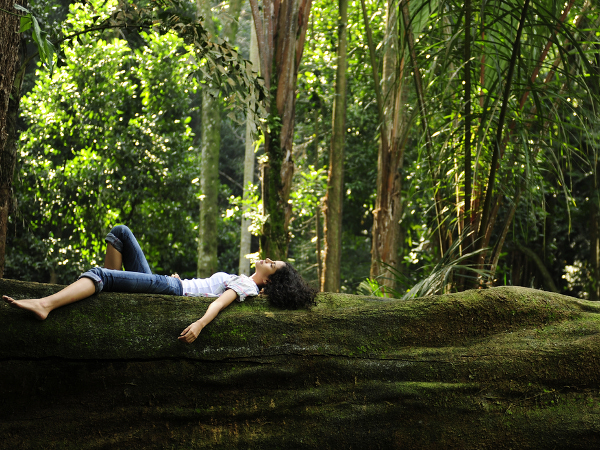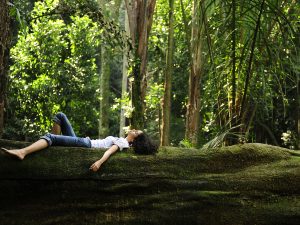“The gap between the natural setting, for which our physiological functions are adapted, and the highly urbanized and artificial setting that we inhabit is a contributing cause of the “stress state” in modern people.” – Ikei and Miyazaki, International Journal of Environmental Research and Public Health
Contents
What is nature therapy?
It’s any practice that involves nature in a therapeutic intervention with humans. Let’s get the science in there right away – nature therapy really works. It could involve animals, walking in the countryside, on a beach, in a forest, and/or doing things in nature, like gardening. People will often do this kind of thing automatically, and feel better for it; but therapy involves a therapist, facilitator or catalyst who will set up the experience (depressed people may not bother to go into nature themselves, or to seek company).

Animals are often used in nature therapy. Horses are a favourite.
Often, when people enter the mental health system, they’re automatically prescribed medication, ignoring the free resource provided by nature, without any side effects (apart from the occasional nettle sting or spot of sunburn). We’re not saying that nature therapy should completely replace medication or talking therapies, just that it could be taken into consideration a lot more than it is, and in many cases, it will be all that is required.
The structure of the therapy depends on the facilitator. Some might involve the use of therapeutic language, with a psychologist / psychotherapist / counsellor; other approaches may involve the belief that nature doesn’t need language, but is therapeutic in itself. Nature therapy is an umbrella term that takes in the broader ‘ecotherapy’, or ‘ecopsychology’, which involves psychologists using a more nature-based approach.
Traditional Japanes Shinrin-Yoku forest therapy.
Nature therapy works with all senses to elevate mood. For example, the smell of terpenes (from coniferous trees) or the sound of birdsong are known to improve mood and reduce anxiety and depression; and the physical exercise involved in moving through nature improves mood too. Nature therapy can help with recovery from addiction too, and the health benefits of having an allotment for older people are well-known.
History
Of course, traditional cultures have always practiced nature therapy as part of their daily routine; the modern nature therapy movement originated with the Quakers, who used nature therapy from the 16th century, for people who would otherwise have been admitted to brutal institutions. They owned farms where people would go to recuperate whilst doing useful outdoor work.

Humans have evolved with the smells, sights and sounds of nature. Modern life has shrunk the sensory world of most people.
Japan has a long nature therapy tradition. Shinrin-yoku, or ‘forest bathing’, involves immersion in a woodland setting. Doctors in Japan have long prescribed short amounts of time in woodland to improve mental health.
Nature isn’t just forests of course – the therapeutic effects of mountains or oceans are just as effective, as well as therapy involving particular species of animal. Equine-assisted therapy, for example, is a well-established therapy that involves working with and riding horses.
Nowadays, the majority of practitioners already have a professional background as a counsellor or therapist, and have added nature therapy to their professional profile.

For the first time in human history, more of us now live in urban than rural areas, and at the same time, screen time has replaced outdoor play for many children.
What are the benefits of nature therapy?
Nature therapy is particularly important now that, for the first time in history, over 50% of the world’s population live in urban areas – and this will rise to 70% by 2050. Younger people especially are spending a large proportion of their time indoors, in front of a screen. Our sensory world has shrunk. Urbanisation and separation from the natural world has been linked to a deterioration in mental health. Walking in a natural environment reduces the neural activity associated with a risk of mental illness, and boosts immunity, compared to walking for the same amount of time in an urban environment. Apparently, the chemicals that plants emit to protect themselves from rot and pests are also good for humans.
When we are divorced from nature, we’re divorced from the physical basis of our existence. Separation from nature is bad for us – it’s as simple as that. Time spent as far from human technology as possible is time well spent, in terms of our physical and mental health – and yes, our spiritual health as well, or whatever the correct word is – some sort of well-being that can’t be defined in terms of physiology or psychology. We’ve evolved to live closely with the rest of nature, and our society is defying that evolution. Connection with nature is good for individuals and for communities.

Shinrin-yoku, or forest bathing, involves immersion in a woodland setting, but it doesn’t have to involve water.
Nature therapy reduces the need to fund corporate drug companies; and pharmaceutical prescriptions like Prozac, can have side-effects such as insomnia, diarrhoea, flu symptoms and nausea, when in fact, communing with nature has been shown to be effective in treating PTSD, but without the side-effects, or corporate profits.
Most mental health practitioners work indoors, under artificial lights, in clinical conditions. There is a significant level of burn-out in the profession. Nature therapists get nature therapy themselves, which can prevent burn-out and give them a new lease of life.
If you have access to nature nearby, you can treat yourself, for free, as often as you like. Nature therapy is beneficial for all ages, and if the benefits of green spaces are more widely understood, more land migh be put aside for trees and other plants and animals, and it could turn out to be good for nature too.
Yes, this is ironic – beautiful nature, but on a screen. But if it inspires people to get out and experience the real thing, then it’s done its job.
What can I do?
Receiving nature therapy
For mild cases of stress or anxiety, you can get yourself into nature to see if it makes you feel better. If your problems require more focused treatment, you could join a ‘nature quest’ – a group meet-up that involves walking and observing nature. It’s different from just going for a walk, in that it’s more purposeful – the group can keep you focused, and the ‘quest’ involves seeking knowledge or understanding.

Getting into nature as a group can have additional social benefits, and help keep you focused on the therapeutic aspects of the experience.
Animals can be unpredictable, and can often teach us things about ourselves that we hadn’t understood before. Nature therapist Kim Brown tells us that during a horse therapy nature quest, a client was bitten by a horse She realised that she wasn’t being respectful to the animal, and she gained the insight that she sometimes behaved that way with people too (but usually, people don’t bring that to her attention by biting her). She was able to gain this insight by talking with other people on the quest – which she may not have done had she been alone. Humans have evolved to live in tribes, as well as existing close to nature, and there are psychological benefits to be gained by interacting in social groups. Helping people to do things like climb over gates, collect wood for a fire etc. has a bonding effect in a social group.

Sometimes, nature therapy can involve getting cuddly with more unusual animals, like wolves. Yes, really.
You can search for nature therapists locally. There are also holidays available with a nature-therapy focus – again, search online. Take the time to see what feels intuitively right for you. Are you drawn towards forests, mountains, rivers, beaches or animals (and what species)? Try to remember what fascinated you about nature when you were a child. This may seem too silly as an adult, so you may have to attempt to connect with your ‘inner child’. Therapists are more catalysts than experts; individuals are in the best position to gauge what they enjoy and what makes them feel better. When people start to take ownership of their own expertise and experiences, and things start to work, then that’s therapeutic in itself, and the beginning of healing.

You get health and well-being benefits as well as fresh veg if you have an allotment.
Becoming a nature therapist
No professional qualifications are required at the moment. This will happen, and it may well be a good thing, although there’s a danger that some of the inherent creativity and freedom may be lost when more structure is introduced. Stricter application of health and safety regulations may prevent people from climbing that tree / swimming in that river / getting too close to that animal etc.
Courses are available, although there is no central organisation / registration as yet, so just search online. If you’re already a therapist, adding nature therapy to your practice will add value professionally and in terms of your personal growth.

A better cure for depression than Prozac?
Specialist(s)
Thanks to Kim Brown of Nature Therapy CIC for information and images.
The specialist(s) below will respond to queries on this topic. Please comment in the box at the bottom of the page.

Dr Kim Brown is a health scientist and founder director of Nature Therapy CIC, offering unique experiences in nature aimed at enhancing sensory intelligence, involving forest bathing and labyrinth therapy, courses involving horses and wolves, plus ‘Think Like an Octopus’, ‘Travelling Dementia Suitcase’, and a survival programme for children aimed at building mental resilience. They’re based in an area of outstanding natural beauty on the Isle of Wight.



2 Comments
Hi Kim,
I have just taken up a new role as a program coordinator for a Nature-based Wellbeing program in Canberra, Australia. I come from a background as a Museum presenter and Disability Support Worker. I’m currently studying transpersonal therapies.
I would be interested to hear your insights on sensory intelligence, aspects of engaging young people in nature activities, as well as the Travelling Dimentia Suitcase (as older persons is another group I am looking to engage). This is a new program, being facilitated by a conservation organisation.
Kind regards,
Sally
Hi Sally more than welcome to contact me to discuss – zoom or similar probably the best – kindest Kim